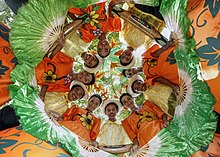Mass media in the Philippines
This article has multiple issues. Please help or discuss these issues on the talk page. (Learn how and when to remove these template messages)
|
| Part of a series on the |
| Culture of the Philippines |
|---|
 |
| People |
| Languages |
| Traditions |
| Cuisine |
| Festivals |
| Religion |
| Art |
| Literature |
|

In 2004, the Philippines had 225 television stations, 369 AM radio broadcast stations, 583 FM radio broadcast stations, 10 internet radio stations, 5 shortwave stations and 7 million newspapers in circulation.[1]
Some media outlets, such as PTV/RPN/IBC (television) and the Philippine Broadcasting Service (radio), are government-run. Most outlets are privately owned.[1]
The most widely read newspapers are the Manila Bulletin, The Philippine Star, Philippine Daily Inquirer, Business Mirror, and BusinessWorld.[1]
Media culture[]
Much media ownership is concentrated in the hands of prominent families and businesses. Consequently, some reports tend to be one-sided presentations favoring special interests. The privately-owned press also tends toward sensationalism at times.[1]
While the media companies are predominantly owned by moneyed and influential tycoons, the Filipino readers are given the option with the advent of the new media and this has leveled the playing field. Reputable online news publications or news portals, blog sites, and other online available resources has disrupted the readership of other giant news media companies.
Some giant media companies in the broadcasting industry have adapted also in the online news portal this include GMA Network, ABS-CBN Corporation, TV5 Network, and government owned television network PTV4.
This strategy was strongly considered due to the growing number of Filipinos who use social media instead of television in watching the news through snippets or short video clips.
Due to the proliferation of disinformation and fake news, Filipino readers have turned to alternative news sources.[citation needed] Other alternative media outlets present in the Philippines include Tudla Productions, Southern Tagalog Exposure, Mayday Multimedia, Altermidya,[2] and Bulatlat.[3]
Freedom of the press[]
The Office of the President is responsible for managing the government’s policy toward the press. Freedom of speech and freedom of the press are enshrined in the 1987 constitution. Although independent observers credit the government with respecting freedom of the press in general, the government has been criticized for failing to investigate thoroughly summary killings of journalists and for subjecting journalists to harassment and surveillance.
Violence against journalists[]
The Philippines is considered among the most dangerous countries in the world according to various media watchdogs. The fifth annual Worldwide Press Freedom Index released by the international press freedom watchdog Reporters Without Borders (RSF) has placed the Philippines among the worst-ranked countries for 2006 at 142nd place. It indicated the continuing murders of journalists and increased legal harassment in the form of libel suits as part of the problem in the Philippines.[4] Between 1986 and 2005, 52 journalists have been murdered[5] and most of their killers go unpunished.[6]
The Committee to Protect Journalists ranked the Philippines among the deadliest and most dangerous places for journalists.[7] The Philippines was also ranked as the most dangerous country in Asia for journalists in 2018 according to the Philippine Center for Media Freedom and Responsibility, which tallied 85 attacks on the media in 2018 under President Rodrigo Duterte.[8]
Libel and cyberlibel[]
The National Union of Journalists of the Philippines (NUJP) noted how in 2020 there was a rise in libel and cyber libel cases in the country.[9] Rappler CEO Maria Ressa was among those convicted of cyber libel in a 2020 case involving the retroactive application of a then new cybercrime law to an article that had been published years before.[10]
NUJP has called on Congress to decriminalize libel and cyberlibel, noting how these are “commonly used weapons against independent journalism."[11]
See also[]
- List of newspapers in the Philippines
- List of radio stations in the Philippines
- List of television stations in the Philippines
- Philippine cinema
- Philippine television
- Radio in the Philippines
- Internet in the Philippines
- Kapisanan ng mga Brodkaster ng Pilipinas
References[]
- ^ a b c d Philippines country profile. Library of Congress Federal Research Division (March 2006). This article incorporates text from this source, which is in the public domain.
- ^ "The Good Kind of Independent, Alternative Media". Esquire Philippines. November 24, 2017. Retrieved July 17, 2021.
- ^ "Alternative News in the Philippines". J Source: The Canadian Journalism Project. Retrieved July 17, 2021.
- ^ "Philippines among worst-ranked countries in press freedom index". freeexpressionasia.wordpress.com/. Retrieved August 22, 2007.
- ^ "52 journalists killed since the return to democracy in 1986". May 2, 2005. Retrieved January 27, 2013.
- ^ "Journalist shot dead by gunman in the Philippines". South China Morning Post. October 31, 2021. Retrieved November 9, 2021.
- ^ Manahan, Job (October 29, 2020). "PH out of top 5 deadliest countries for journalists after 10 years, but still 7th most dangerous". ABS-CBN News. Retrieved April 22, 2021.
{{cite web}}: CS1 maint: url-status (link) - ^ Dancel, Raul (November 2, 2018). "Philippines: Most dangerous place for journalists in Asia". The Straits Times. Retrieved April 22, 2021.
{{cite web}}: CS1 maint: url-status (link) - ^ Peña, Dawn (April 20, 2021). "Philippine press freedom ranking slides down on 3rd year". Bulatlat. Retrieved April 22, 2021.
- ^ "World Report 2021: Rights Trends in Philippines". Human Rights Watch. December 16, 2020. Retrieved April 22, 2021.
- ^ Gregorio, Xave (January 15, 2021). "Calls to decriminalize libel resurface as Rappler journalists face yet another libel suit". Philstar. Retrieved April 22, 2021.
{{cite web}}: CS1 maint: url-status (link)
Further reading[]
- Reuters Institute for the Study of Journalism, University of Oxford (2020), "Philippines", Digital News Report, UK, OCLC 854746354
- Mass media in the Philippines
- Mass media by country
- Mass media in Asia by country
